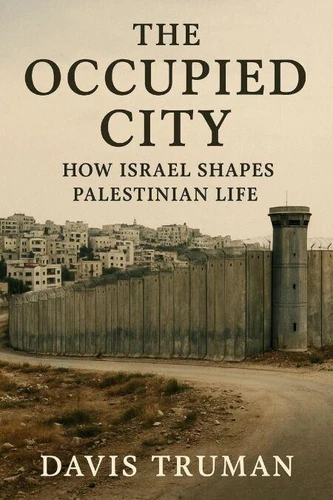The Occupied City How Israel Shapes Palestinian Life
Par :Formats :
Actuellement indisponible
Cet article est actuellement indisponible, il ne peut pas être commandé sur notre site pour le moment. Nous vous invitons à vous inscrire à l'alerte disponibilité, vous recevrez un e-mail dès que cet ouvrage sera à nouveau disponible.
Disponible dans votre compte client Decitre ou Furet du Nord dès validation de votre commande. Le format ePub est :
- Compatible avec une lecture sur My Vivlio (smartphone, tablette, ordinateur)
- Compatible avec une lecture sur liseuses Vivlio
- Pour les liseuses autres que Vivlio, vous devez utiliser le logiciel Adobe Digital Edition. Non compatible avec la lecture sur les liseuses Kindle, Remarkable et Sony
 , qui est-ce ?
, qui est-ce ?Notre partenaire de plateforme de lecture numérique où vous retrouverez l'ensemble de vos ebooks gratuitement
Pour en savoir plus sur nos ebooks, consultez notre aide en ligne ici
- FormatePub
- ISBN8232463632
- EAN9798232463632
- Date de parution29/09/2025
- Protection num.pas de protection
- Infos supplémentairesepub
- ÉditeurDraft2Digital
Résumé
East Jerusalem is more than a city; it is a battleground of maps, walls, and blueprints. In The Occupied City: How Israel Shapes Palestinian Life, readers are taken inside one of the world's most contested urban landscapes, where every building permit, zoning law, and planning decision becomes a tool of power. Drawing on years of research and first-hand interviews with Palestinian residents, urban planners, and human rights experts, this book exposes how Israeli urban planning policies restrict Palestinian access to housing, fracture communities, and rewrite the very geography of Jerusalem.
It reveals how control is exercised not only through military presence but through bureaucratic procedures, economic pressures, and cultural erasure-quiet mechanisms that determine who gets to build, who is forced to leave, and whose story is allowed to endure. At once rigorous and deeply human, The Occupied City gives voice to those living under the daily weight of planning systems designed to dispossess them.
It uncovers the hidden architecture of occupation while also spotlighting acts of resilience, resistance, and visions for a more just future. Essential reading for anyone seeking to understand the Israeli-Palestinian conflict beyond headlines, this book demonstrates how urban planning-often regarded as technical or neutral-is, in fact, one of the most powerful weapons in the struggle over land, rights, and survival.
It reveals how control is exercised not only through military presence but through bureaucratic procedures, economic pressures, and cultural erasure-quiet mechanisms that determine who gets to build, who is forced to leave, and whose story is allowed to endure. At once rigorous and deeply human, The Occupied City gives voice to those living under the daily weight of planning systems designed to dispossess them.
It uncovers the hidden architecture of occupation while also spotlighting acts of resilience, resistance, and visions for a more just future. Essential reading for anyone seeking to understand the Israeli-Palestinian conflict beyond headlines, this book demonstrates how urban planning-often regarded as technical or neutral-is, in fact, one of the most powerful weapons in the struggle over land, rights, and survival.
East Jerusalem is more than a city; it is a battleground of maps, walls, and blueprints. In The Occupied City: How Israel Shapes Palestinian Life, readers are taken inside one of the world's most contested urban landscapes, where every building permit, zoning law, and planning decision becomes a tool of power. Drawing on years of research and first-hand interviews with Palestinian residents, urban planners, and human rights experts, this book exposes how Israeli urban planning policies restrict Palestinian access to housing, fracture communities, and rewrite the very geography of Jerusalem.
It reveals how control is exercised not only through military presence but through bureaucratic procedures, economic pressures, and cultural erasure-quiet mechanisms that determine who gets to build, who is forced to leave, and whose story is allowed to endure. At once rigorous and deeply human, The Occupied City gives voice to those living under the daily weight of planning systems designed to dispossess them.
It uncovers the hidden architecture of occupation while also spotlighting acts of resilience, resistance, and visions for a more just future. Essential reading for anyone seeking to understand the Israeli-Palestinian conflict beyond headlines, this book demonstrates how urban planning-often regarded as technical or neutral-is, in fact, one of the most powerful weapons in the struggle over land, rights, and survival.
It reveals how control is exercised not only through military presence but through bureaucratic procedures, economic pressures, and cultural erasure-quiet mechanisms that determine who gets to build, who is forced to leave, and whose story is allowed to endure. At once rigorous and deeply human, The Occupied City gives voice to those living under the daily weight of planning systems designed to dispossess them.
It uncovers the hidden architecture of occupation while also spotlighting acts of resilience, resistance, and visions for a more just future. Essential reading for anyone seeking to understand the Israeli-Palestinian conflict beyond headlines, this book demonstrates how urban planning-often regarded as technical or neutral-is, in fact, one of the most powerful weapons in the struggle over land, rights, and survival.



